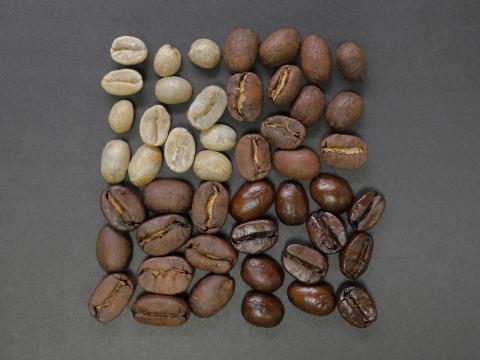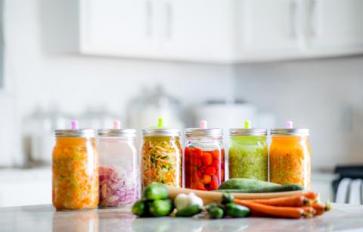
Now’s the time to buy local coffee, with single-origin beans and small-batch roasters overrunning the shelves at local super markets and coffee shops alike. Just like consumers developed their palates for local produce and even local wines (in some parts of the country), they’re starting to venture into the world of local coffee roasts. Everything from the coffee bean origin to the roasting process affects the different flavors found in light, medium, medium-dark and dark roasts. A better understanding of all these factors will help locavores enhance their palates and get a better idea of what to expect from your local roaster.
Farm to Roaster: The Coffee Bean Lifecycle
While locavores are obviously dedicated to buying from local sources, unfortunately, coffee cannot be grown in the Continental U.S. It can only be grown in tropical climates—Brazil, Guatemala, Ethiopia, Kenya, Peru, Ecuador and Indonesia, for example. Luckily for coffee makers, these countries have different growing seasons, so fresh batches of coffee beans come from each at various times of the year.
Like grapes in wine, there are different coffee varietals, and the flavor of coffee can be dependent on where it’s grown, how it’s grown and what’s in the soil. For instance, Ethiopian coffee beans tend to produce bright coffees with a lot of acidity and a floral or fruity taste to them, says Adrienne Small, owner and roaster for A Small Coffee, a small roasting company based in Santa Rosa, Calif. Guatemalan coffees tend to feature more caramel flavors with lower acidity, and Sumatran or Indonesian coffees have more earthy flavors.
The Roasting Process
Once a coffee roaster gets the green coffee beans, the beans have to go through the roasting process before they can be used to make a drink. In general, coffee loses about 15 to 20 percent of its weight during the roasting process, which involves dropping beans into a roaster (or, in smaller cases, an air popcorn popper) at a temperature of about 420 degrees Fahrenheit.
The first part of the roasting process is called “yellowing” in which most of the moisture leaves the bean, turning it into an actual brown color. Then, there’s first and second crack, which is literally when the coffee bean makes a cracking or popcorn-popping sound due to the heat being applied. At first crack, the bean starts smelling like coffee and is considered a light roast.
“Coffee nerds are very interested in light roast or single-origin coffee now because you can really taste the origins from which the coffee came,” says Small. “However, big coffee drinkers typical prefer dark roast coffees.”
After first crack, the bean starts to develop its natural sugars, and the heat applied begins to release them. This is when consumers will start to taste the impact of the roasting process on the beans. Right before second crack is considered a medium roast, which has a much more balanced flavor. When you hit second crack, the oils start to be released from the bean, and you can see it become shiny in a medium-dark and then dark roast. Dark, oily coffee beans are typically strong tasting, bold and bitter, as the sugars have started to carmelize.
While a common myth is that light roasts retain most of the caffeine from the coffee bean because they were roasted the least, there is actually very little caffeine lost in the roasting process. The amount of caffeine in a cup of coffee typically depends on the barista and the coffee-to-water ratio.
The Difference Between Roasts
So, you know about the coffee process, but what kind of coffee do you prefer? While the origin and processing of the coffee certainly affects taste, the roast level provides a better guide to the taste consumers can expect. Here’s a basic definition of the tastes and characteristics of light, medium, medium-dark and dark coffee roasts.
Light: Visually, a light roast is a lighter brown, and the bean is not necessarily smooth because it has yet to release any shiny oils. It will have a brighter, more acidic taste that’s typically on the sweeter side, and it will have a lighter body. According to the National Coffee Association USA (NCA), common names for light roasts are Light City, Half City and Cinnamon.
Medium: This bean is a darker brown and has a smoother texture but still hasn’t released much oil. When ground, the bean will have less of the citrusy flavors and instead more of the caramel and chocolate tastes. It’s also more balanced because both the origin of the coffee and the roasting process are working together to create a variety of flavors. According to the NCA, common names for light roasts are City, American and Breakfast.
Medium-Dark: At this roasting point, the bean starts to lose its acidity, and the citrusy or fruity flavors will be muted. Like the medium roast, a medium-dark roast features hints of caramel and chocolate, and it has a heavier body with an almost syrupy texture. According to the NCA, a common name for medium-dark roasts is Full City.
Dark: These are very dark, smooth beans that have an oil sheen on them. They have a darker, bitterer taste, but the body starts to thin out at second crack during the roasting process, so the texture is thinner and smoother. According to the NCA, common names for dark roasts are French Roast, Continental Roast, Italian Roast, Viennese Roast and New Orleans Roast.
Now that you know the coffee lingo, make sure to chat up local coffee roasters about your personal roast preferences to get a better understanding of the coffee you drink and purchase. Just like any local artisan, the person roasting your coffee knows the most about where the coffee beans are sourced and how they’re being processed, which can make all the difference when it comes to taste and social responsibility.








